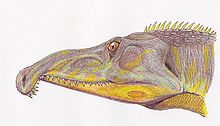- Proterosuchus
-
Proterosuchus
Temporal range: Early Triassic Early Triassic
Proterosuchus fergusi from the Early Triassic of South Africa Scientific classification Kingdom: Animalia Phylum: Chordata Class: Reptilia Subclass: Diapsida Infraclass: Archosauromorpha (unranked): Archosauriformes Family: Proterosuchidae Genus: Proterosuchus
Broom, 1903Species Proterosuchus fergusi Broom, 1903 (Type)
Proterosuchus yuani
(Young, 1936) Cruickshank, 1970
Proterosuchus ultimus
(Young, 1964) Cruickshank, 1970Synonyms - Chasmatosaurus Haughton, 1924
- Elaphrosuchus Broom, 1946
Proterosuchus is an extinct genus of Early Triassic proterosuchid archosaur. Remains have been found from South Africa and China. The genus Chasmatosaurus is considered a junior synonym of Proterosuchus, as all species of Chasmatosaurus, including C. aleandri, C. vanhoepeni, and C. yuani, have been reassigned to Proterosuchus. Elaphrosuchus has also been synonymized with Proterosuchus. The type species of Proterosuchus is P. fergusi. Two other species, P. ultimus and P. yuani, have also been named.
Contents
Description
Proterosuchus was one of the largest land reptile during the Early Triassic period, equivalent in size to today's Komodo dragons. It looked somewhat similar to a primitive crocodile, and shared many of their modern features like long jaws, powerful neck muscles, short legs and a lengthy tail, while possessing several features unique to proterosuchids such as its hook-shaped mouth. This jaw may have been an adaptation for catching prey, such as the dicynodont Lystrosaurus. Proterosuchus, like most modern crocodiles, is theorised to be an ambush predator, waiting for its prey to enter the water, at which point they would be attacked from below the surface, using the long, muscular tail for swimming and pushing through the water at speed. However, the animal also had stout legs that enabled it to walk comfortably at land. Being able to move between the land and the water was a great advantage, and enabled Proterosuchus to control its body temperature by sunbathing or cooling off in the water. Being an ambush predator like some present-day crocodiles meant that for the most part Proterosuchus remained in one environment for most of its life. This worked as an excellent means of conserving energy, even giving it the capability of surviving for perhaps months at a time without food.
Although it could live and swim in the water, Proterosuchus may have preferred to hunt land animals rather than fish. Its eyes were located on the top of its head, allowing it to hide just under the surface of the water, where it would wait for animals to come and drink. When close enough, Proterosuchus would spring upwards and drag its victim into the water, drowning and then eating it.
Comparisons between the scleral rings of Proterosuchus and modern birds and reptiles indicates that it may have been cathemeral, active throughout the day during short intervals, supporting the idea that early archosaurs adapted to dim light. However, as Proterosuchus may have been a polar animal, it likely lived under different lighting conditions from typical archosaurs and may not have inherited such adaptations from a common ancestor with archosaurs.[1]
Species
The type species of Proterosuchus is P. fergusi, named by Robert Broom in 1903 from Tarkastad, Eastern Cape in South Africa.[2] It has been found from the Lystrosaurus Assemblage Zone of the Beaufort Group in the Karoo. Several other species of proterosuchids have been described from the Karoo, including Chasmatosaurus vanhoepeni in 1924,[3] Elaphrosuchus rubidgei in 1946,[4] and Chasmatosaurus alexandri in 1965.[5] These species were distinguishable from one another on the basis of size-related characteristics. More recently, these characteristics have been considered to represent different stages in the growth series of one species.[6] Because the name Proterosuchus fergusi has seniority, the other species have been synonymized with P. fergusi.
A new species of Chasmatosaurus, C. yuani, was described from Xinjiang, China in 1936. It has been found from the Cangfanggou Group near Jimsar, northeast of Ürümqi.[7] It was reassigned as a new species of Proterosuchus in 1970.
Classification
Proterosuchus is an example of an early archosaur, the group which encompasses crocodiles, pterosaurs, dinosaurs, and birds. It was once believed to have been an ancestor to the crocodilians, but it is now known to be far more basal.
Popular culture
Proterosuchus was featured in episode 5 of Animal Armageddon as well as in the BBC documentary Walking with Monsters.
References
- ^ Schmitz, L.; Motani, R. (2011). "Nocturnality in Dinosaurs Inferred from Scleral Ring and Orbit Morphology". Science in press. doi:10.1126/science.1200043. PMID 21493820.
- ^ Broom, R. (1903). "On a new reptile (Proterosuchus fergusi) from the Karroo beds of Tarkastad, South Africa". Annals of the South African Museum 4: 159–164.
- ^ Haughton, S.H. (1924). "On a new type of thecodont from the Middle Beaufort Beds". Annals of the Transvaal Museum 11: 93–97.
- ^ Broom, R. (1946). "A new primitive proterosuchid reptile". Annals of the Transvaal Museum 20: 343–346.
- ^ Hoffmann, A.C. (1965). "On the discovery of a new thecodont from the Middle Beaufort Beds". Researches of the National Museum, Bloemfontein 2: 33–40.
- ^ Welman, J. (1998). "The taxonomy of the South African proterosuchids (Reptilia, Archosauromorpha)". Journal of Vertebrate Paleontology 18 (2): 340–347.
- ^ Lucas, S.G. (1993). "Vertebrate biochronology of the Triassic of China". In Lucas, S.G. and Morales, M. (eds.). The Nonmarine Triassic. New Mexico Museum of Natural History & Science Bulletin. pp. 301–306. http://econtent.unm.edu/cgi-bin/showfile.exe?CISOROOT=/bulletins&CISOPTR=1098&filename=2370.pdf.
Haines, Tim, and Paul Chambers. The Complete Guide to Prehistoric Life. Pg. 58. Canada: Firefly Books Ltd., 2006
Categories:- Archosaurs
- Triassic reptiles
Wikimedia Foundation. 2010.



